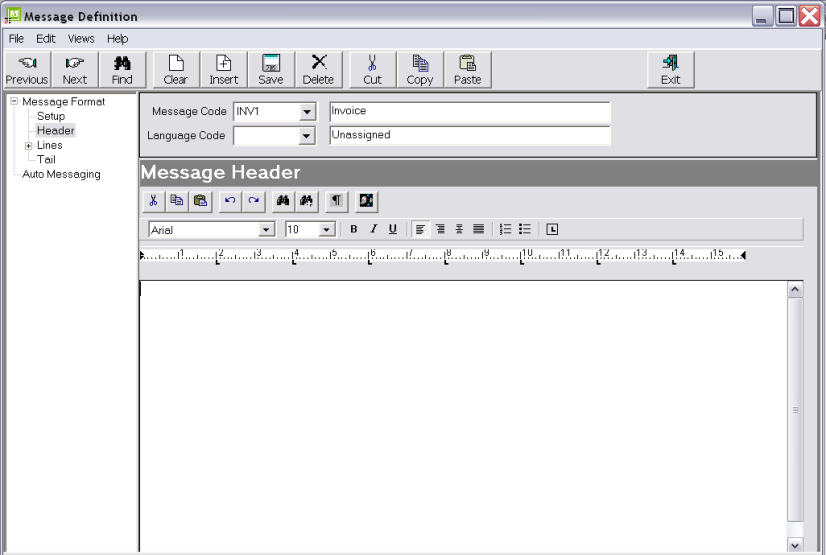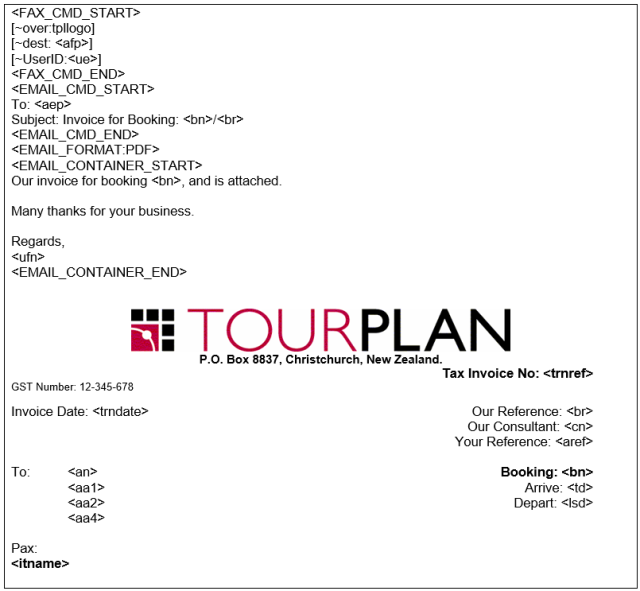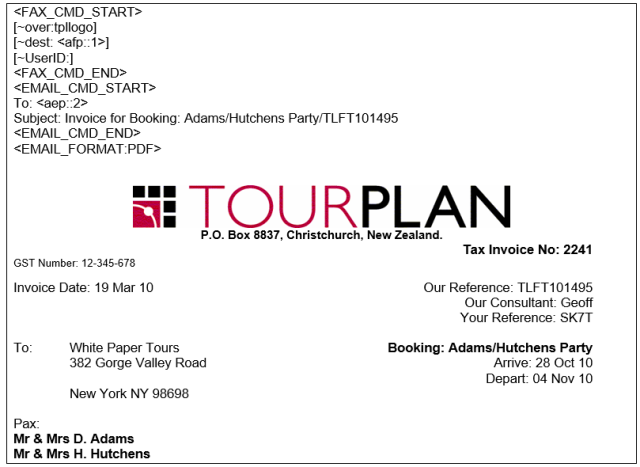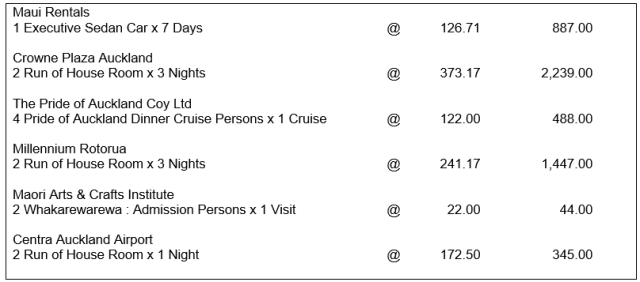Open topic with navigation
(continued from Voucher Message)
Invoice/Credit Note
This message type is used to output debtor invoices. A copy of the format can be made and references to Invoice can be changed to Credit Note to enable Credit Notes to be output.
It is possible to have multiple types of invoice message—e.g., an FIT Booking Invoice, a Group Booking Invoice, Invoice with line costs, invoice with totals only etc. If dealing with retail agents, some invoice layouts could include Agent Commission.
Set up screen settings: Message type—Invoice, Fixed/Floating Length depending if pre printed stationery is being used.
|

|
Invoice Messages are unable to output booking service line detail. Basic service details (as are stored in the Product Invoice Text fields) can be output, along with first and second charge unit quantities and descriptions. Detail such as service date, location, quantity & type of room etc. should be excluded from the invoice template. Some of this detail is available if the Operations/Batch Invoicing method is being used. That application features an optional switch to obtain booking information, but when turned on, invoice generation is extremely slow due to the system having to recover all bookings related information to output on the invoice.
|
Header Section
The Header of a message is that section at the beginning of the message which contains addressing information and generic text.
Screen Shot 214: Invoice Message Template Header Screen

|

|
The Tree Menu items on the left side of the editing screen are those that are able to be used in a Booking Agent Message—they do not have to be used.
|
For Invoice type messages, the first decision to be made is how the message is to be sent. The System INI setting ALLOW_FAX_EMAIL_SWITCHING can be set to allow automatic switching from Email to Fax, and Fax to Email if the required addressing/numbers are not found. This means that if a message is sent via email, and there is no valid email address found for the agent/supplier, the system will automatically switch to sending via fax. (Auto faxing software is required for this feature to work).
Another consideration is, if the message that this template is for is to be predominately sent via email, should the message be sent as an attachment, or just as the body of the email.
|

|
Email sent from Tourplan messages are sent as plain text, so most formatting is lost if the message forms the body of the email.
|
|

|
It is recommended that any unwanted tab stops are removed in the editing screen. Unnecessary stops can cause formatting issues on message output.
|
The message header should contain basic Agent Name, Address, Fax/Email details, as well as text to support the message. In this example, the message will be designed to be sent as a PDF attachment (see more under Email Attachments). This means that the template header will hold:
Fax Commands
Email Commands
Attachment Commands
Email Container (the message that will carry the attachment), as well as the generic text and invoice header detail required.
Example 81: Invoice Message Template Header

The lines in the header in Example 81: Invoice Message Template Header Example 81: Invoice Message Template Header from <FAX_CMD_START> to <EMAIL_CONTAINER_END> are Fax and Email related.
|

|
The fax commands in this example are used by TNZ Faxware. Different commands will apply to other fax software.
The [ ] brackets are being used to identify TNZ Faxware specific commands. The ~ preceding the commands tell TNZ Faxware not to print the line on the fax.
The Tourplan specific commands inside the fax commands (<afp> and <ue>) will be substituted before the message is passed to the fax software.
During message editing, all commands and tags are displayed in the message, since at that point Tourplan does not know how the message is going to be sent. When the send method has been determined, Tourplan strips out any unwanted commands. If the message is sent via fax, all email commands are removed; if the message is sent via email, all fax commands are removed.
|
<FAX_CMD_START>Indicates all lines until <FAX_CMD_END> will be passed to the faxing software.
[~over:tpllogo]The command to tell Faxware which logo file to overlay on the fax during sending (Not a Tourplan command).
[~dest:<afp>]The message destination. <afp> is a Tourplan code which will retrieve the Agent Fax number from the Tourplan Phonebook.
[~UserID:<ue>]TNZ Faxware uses this command to identify in log files which user sent the fax. Tourplan will substitute the Users Email address for <ue> on output.
<FAX_CMD_END>Indicates the end of fax commands.
<EMAIL_CMD_START>Indicates all lines until <EMAIL_CMD_END> will be passed to the email client software.
To: <aep>Standard SMTP addressing for the email recipient. Tourplan will substitute <aep> for the Agent Email address from the Phonebook.
Subject: text <bn>/<br>The subject line of the email which will be passed to the email client. Tourplan will substitute the Booking Name for <bn>, and the Booking Reference for <br>.
<EMAIL_CMD_END>Indicates the end of email commands.
<EMAIL_FORMAT:PDF>Indicates that the attachment is to be converted to PDF format. Not required if the message is not being sent as an attachment.
<EMAIL_CONTAINER_START>The text between this command and <EMAIL_CONTAINER_END> is the email message that the recipient receives which carries the PDF attachment. Tourplan will substitute <bn> for the Booking Name. Not required if the message is not being sent as an attachment.
<EMAIL_CONTAINER_END>Indicates the end of the container message.
|

|
The balance of the message (from <EMAIL_CONTAINER_END>) is what will be attached in PDF format to the container email.
|
The logo has been copied/pasted from a word processing document. The following substitutions will be made in the remainder of the header:
<ufn>User full name.
<trnref>Transaction reference (invoice) number
<trndate>Transaction date.
<br>Booking Reference.
<cn>Booking Consultant.
<aref>Agent Reference field.
<an>Agent Name.
<aa1>-<aa4>Agent Address lines 1, 2 & 4. :m= Agent (M)ailing address, not (P)hysical address.
<bn>Booking Name.
<td>Booking Travel date.
<lsd>Booking Last Service date.
Example 82: Invoice Message Header Output

Lines Section
The lines section for an invoice can be the same for all service types—after all, minimal service detail is able to be output, so there is no real necessity to set up different line types. The generic blank/Unassigned line type can be used.
Examples are given which show detailed line costs, summary line costs and no line costs.
Summary Line Costs Example
Example 83: Invoice Message Lines–Summary Costs

The following substitutions will be made in the lines:
<rms>/<rme>Remove text start/Remove text end. :bl = Replace text with a blank line if the substitution code(s) between <rms:bl> and <rme:bl> return blank. Placing <rme:bl> after the carriage return at the end of the line (i.e. on the line below) removes that carriage return as well.
<trndesc1>Transaction (Option Invoice Text) description field 1
<trndesc2>Transaction (Option Invoice Text) description field 2
<trnext>Transaction extended price.
Example 84: Invoice Message Lines–Summary Costs Output

Detail Line Costs Example
Example 85: Invoice Message Lines–Detail Costs

This example is also using the first and second charge units and quantities, as well as the item price and extended price. In addition to the substitution codes used in Example 84: Invoice Message Lines–Summary Costs Output Example 84: Invoice Message Lines–Summary Costs Output, the following substitutions will be made in the lines:
<trnqty1>Transaction quantity 1—i.e., First charge unit quantity
<fcu>First Charge Unit description—Room, Admission etc.
<trnqty2>Transaction quantity 2—i.e., second charge unit quantity. :rl = Remove text to end of line if the substitution code(s) between <rms:rl> and <rme:rl> return blank.
<scu>Second Charge Unit description—Nights etc.
<trnprice>Transaction Unit price
Example 86: Invoice Message Lines–Detail Costs Output

|

|
In Fastbook bookings where multiple rooms are involved and the room value is different per room—e.g., one room has a child in it—then the Transaction Price (<trnprice>) is the average of the total room prices.
|
No Line Costs Example
Example 87: Invoice Message Lines–No Costs

This example is using just the first and second transaction description fields. The descriptions of the <trndesc1> and <trndesc2> substitution codes are used in Example 84: Invoice Message Lines–Summary Costs Output.
Example 88: Invoice Message Lines–No Costs Output

Tail Section
The tail section for an invoice can be as simple or as complex as needed. As with any message type, the detail required will depend on User Company requirements. Detail can include such things as payments received to date, commission values, tax (either included or excluded value) etc. Following is a simple tail.
Example 89: Invoice Tail

The following substitutions will be made in the tail:
<trndue>Transaction Payment Due date
<cur>The currency code of the transaction
<trntot>Transaction total
<trntax>Transaction tax amount.
Example 90: Invoice Tail Output

(continued in Remittance/Cheque)
Open topic with navigation











